This is an AGFA Selectronic 3, a 35mm SLR made in Japan by Chinon Industries for AGFA, starting in 1980. The Selectronic 3 was a rebadge of the Chinon CE-4 and shared almost all of that camera’s features, including it’s Pentax K-bayonet lens mount and aperture priority automatic exposure. The Selectronic 3 differs from the original Chinon model with unique styling by the German firm Schlagheck & Schultes who had designed a number of other AGFA branded cameras in the 1970s, a very large reddish-orange shutter release button, and a relocated double exposure slider on the front face of the camera. A selection of AGFA branded lenses were also available as well. The Selectronic 3 was in production for about 3 years, being discontinued sometime in 1983.
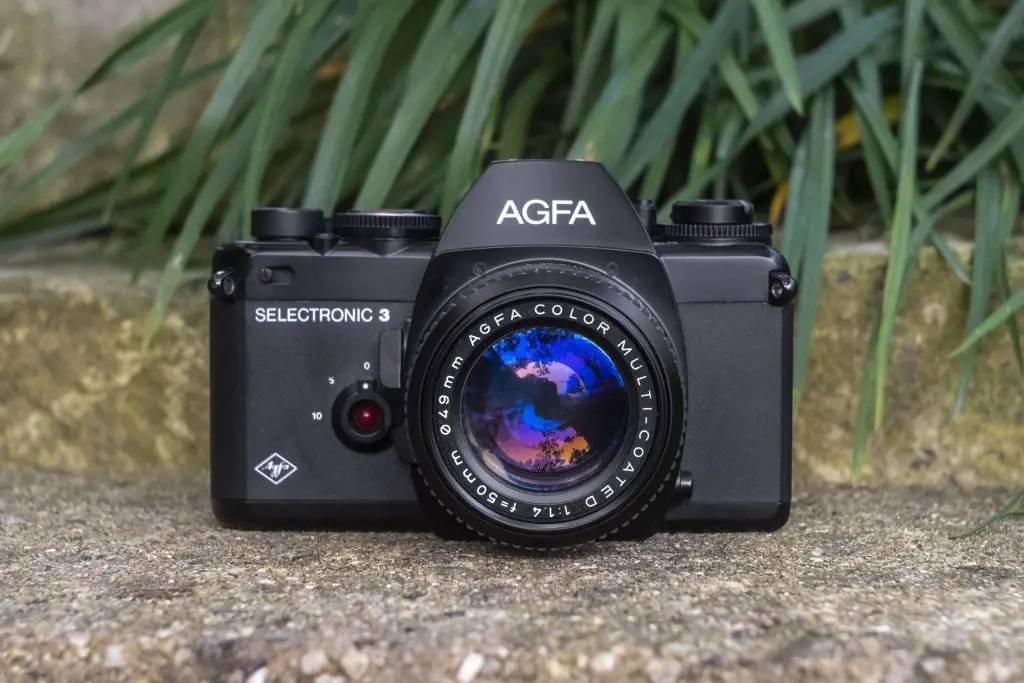 Film Type: 135 (35mm)
Film Type: 135 (35mm)
Lens: 50mm f/1.4 AGFA Color Multi-Coated coated 7-elements in 5-groups
Lens Mount: Pentax K Bayonet
Focus: 1.5 feet/0.45 meters to Infinity
Viewfinder: Fixed SLR Pentaprism with Shutter Speed Scale
Shutter: Seiko MFC Vertically Traveling Metal Focal Plane
Speeds (Auto): 8 – 1/1000 seconds, step less
Speeds (Manual): B, 4 – 1/1000
Exposure Meter: Coupled SPD Cell w/ Aperture Priority AE
Battery: (3x) 1.5v SR44 Silver Oxide Battery
Flash Mount: Hot shoe and M and X Flash Sync, 1/60 X-sync
Weight: 740 grams (w/ lens), 490 grams (body only)
Manual (Similar Model): https://www.butkus.org/chinon/chinon/ce-4/chinon_ce-4.pdf
How these ratings work |
The AGFA Selectronic 3 is a rebadged Chinon Memotron CE-4, so anything that can be said about that camera can be said about the AGFA. Unlike most other rebadges however, the Selectronic 3 is different enough both in design and functionality to warrant a unique look. With a sturdy and all plastic body, along with one of the largest shutter release buttons ever found on an SLR, the Selectronic 3 is a joy to hold and shoot. It’s got a great lens, good looks, and excellent viewfinder, making this uncommon German cousin to the Japanese Chinon, a winner! | ||||||
| Images | Handling | Features | Viewfinder | Feel & Beauty | History | Age | |
| 2 | 2 | 1 | 2 | 2 | 1 | 0% | |
| Bonus | none | ||||||
| Final Score | 10.0 | ||||||
History
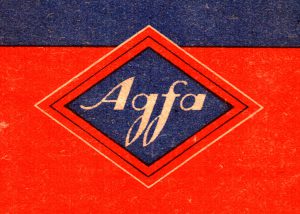 The comparisons of the history for both Eastman Kodak and AGFA throughout the 20th century are eerily similar. Both companies were founded in the late 1800s, first producing chemicals for the photographic industry and both releasing a new product that had a huge and longstanding impact on the industry with Rodinal and Eastman’s Dry Plates.
The comparisons of the history for both Eastman Kodak and AGFA throughout the 20th century are eerily similar. Both companies were founded in the late 1800s, first producing chemicals for the photographic industry and both releasing a new product that had a huge and longstanding impact on the industry with Rodinal and Eastman’s Dry Plates.
In the early 20th century, both companies expanded their photographic chemicals, and eventual film operations to include cameras which were usually built cheaply, in an effort to help sell film. Each company followed the belief that the more people who bought their cameras, the more customers they would have for their film.
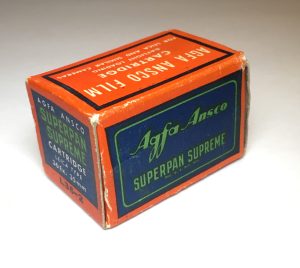
In the 1930s, both companies released their own competing forms of double perforated 35mm cinema film, with AGFA Karat, and Kodak’s Type 135 film. Both companies produced black and white, color print, and color transparency films that at various points throughout their history, were both very successful.
Throughout the middle of the 20th century, both companies offered lower cost cameras made in the United States as cost effective options, along with cameras like the Retina and Karat series made in Germany as higher cost options.
AGFA and Kodak’s “film first” philosophy became more evident in the 1960s, when with immense competition from the Japanese camera industry, decided that it no longer made economic sense to produce their own cameras in house, and would focus most of it’s energy into each company’s film products with the occasional outsourcing of cameras to a Japanese maker. Kodak would later use companies like Cosina and Sedic to produce point and shoot 110 and 35mm options later in the decade, and in 1980, AGFA would partner with Chinon to produce a series of 35mm SLR cameras called the AGFA Selectronic.

Before I continue, I need to step back to 1967 when an independent German design studio named Schlagheck & Schultes was founded by Norbert Schlagheck and a former Siemens employee named Herbert H. Schultes. Schlagheck & Schultes aimed to create industrial and commercial designs for various industries, and with Schultes previous relationship with AGFA while working for Siemens, secured a relationship that would modernize AGFA’s design ethos for the next decade and a half.
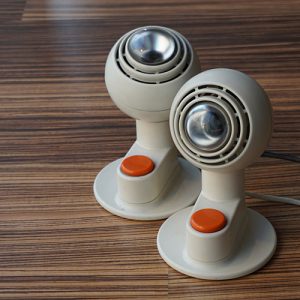
The standout feature of AGFA Cameras designed by Schlagheck & Schultes was a large reddish orange shutter release button prominently located on the top plate of each camera. Schultes liked the red button so much, he used it on other non-camera designs his studio created, such as the Osram table lamps pictured to the right.
Camera-wiki’s page for Schlagheck & Schultes lists 14 different AGFA models designed by them, but in reality, there were many more subvariants of these cameras that all had it too, making the total number much higher.
Although most of the Schlagheck & Schultes designed AGFA cameras were built in Germany, some, like the Agfamatic 1008 Pocket were built in an AGFA factory in Brazil. Most cameras of this era were inexpensive Instamatic and Pocket Instamatic models featuring automatic exposure, focus free lenses, and a limited number of exposure options, but a few, like the AGFA Selectronic S and AGFA Optima Flash were well equipped 35mm rangefinder models with features like full exposure control or a built in pop up flash.
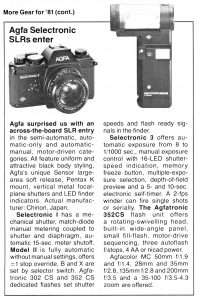
In 1980, with the release of what would become AGFA’s first 35mm SLR in more than a decade, instead of building the camera in house, they partnered with Japanese camera maker, Chinon to release a series of three different AGFA Selectronic SLRs. Each of these three models would be called the Selectronic 1, 2, and 3 and would all be rebadges of existing Chinon models.
- Selectronic 1 – Rebadge of Chinon CM-4, Full manual camera with match LED exposure meter.
- Selectronic 2 – Rebadge of Chinon CA-4, Electromagnetic shutter camera with automatic exposure only.
- Selectronic 3 – Rebadge of Chinon CE-4, Electromagnetic shutter camera with auto exposure and full manual control. (Success to the Chinon Memotron series)
The Selectronic 3, in addition to full manual control plus auto exposure, also came standard with a faster 50mm f/1.4 AGFA Color Multi-Coated lens, and had an option for a battery powered motor drive, and an intentional double exposure lever on the front face of the camera.
The AGFA Selectronic SLRs seemed to be very short lived models and likely were produced in small numbers, making finding information about them difficult today. In my research for this article, the short preview to the right of the series from the November 1980 issue of Modern Photography is the only mention I could find for the cameras in any of the magazines I have access to in that area.
From what little I’ve been able to find, it seems the Selectronic series was targeted for the US market, as back in Germany, the very large photographic retailer, Photo-Quelle had their own rebadged Chinon CE-4, which they sold as the Revueflex AC 2. Unlike AGFA’s model which had some changes to the original Chinon model, the AC-2 was a straight rebadge with no changes. It would seem strange that two different German companies would compete with each other, selling their own versions of the same camera.
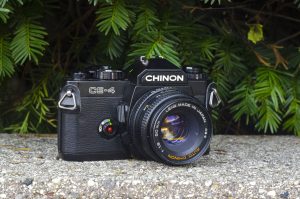
I was unable to find a price for the Selectronic 3, but a catalog for Chicago’s Shutan Camera in the summer of 1981 lists the Chinon CE-4 50mm f/1.9 lens for $239.95, suggesting that with the AGFA brand name and faster f/1.4 lens, the camera likely sold for a little higher than that. Assuming a price of around $250, when adjusting for inflation, the camera likely sold in the ballpark of $850 today making it a solid middle of the road option.
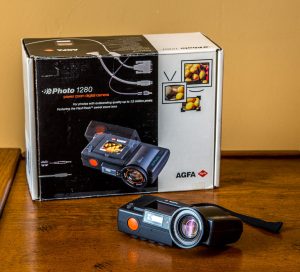
After the discontinuation of the AGFA Selectronic series, like Kodak, AGFA would never again release another 35mm SLR again. Any future AGFA branded cameras were low end cameras whose sole purpose of existence was to further the sales of AGFA (and GAF, AGFA’s parent company) film. As the century closed, AGFA would dabble in digital cameras with a small number of simple digicams like the AGFA ePhoto series which continued the red shutter button design from Schlagheck & Schultes.
Today, AGFA cameras have a spot on most collector’s shelves, but usually these are reserved for the company’s earlier models like the Karat or Optima series. I suspect that a large number of camera collectors are not even aware of the AGFA Selectronic SLRs as they were produced in such low numbers.
For those that do remember them, their elegant and modern looks, along with the positive reputation of the Chinon cameras they are variants of, make them desirable additions to any collection. These cameras don’t often show up for sale, and when they do, they often do not have the original AGFA lens anymore, but if you can find one in good enough condition for a reasonable price, they are definitely worth adding to your collection.
My Thoughts
There gets to be a point as a collector where you start to think you’ve seen everything. There was a finite number of cameras produced over the years and while the first 100 years of photography produced a lot of one-off designs, by the end of the 20th century, camera makers started to converge down to a much smaller selection of cameras and designs.
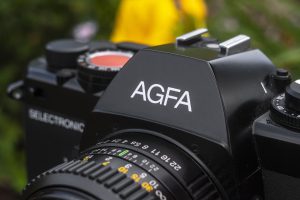
When I first saw a photo of the AGFA Selectronic 3, I thought to myself, “I’ve never seen one of those before” so I began my search. As I stated in my GAS Attack! Buying Cameras on eBay, the number one way to get a camera you want on eBay is to have patience. If you put something on your watch list and just wait, eventually it will come up. It might take months or even years, but in most cases, it does.
When that time came, I jumped at the opportunity to pick up this very nice example with a lens. The only ones I’ve ever seen were body only, and while I could just mount any K-mount lens I had, I really wanted one with the original AGFA branded lens.
If you Google this camera, the only in depth review you’ll find out there is this excellent review over at EMULSIVE from 2017, which I had read numerous times before getting my copy. The thing that struck out to me the most from that review was Mark Brown’s comments about how much plastic the camera had. Fearing a cheaply feeling camera that creaked in your hands every time you picked it up, I nervously awaited that red white and blue box to appear on my porch.
Upon it’s arrival, my first reaction from picking up the Selectronic 3 was that yes, this thing has a lot of plastic, but that amazingly, it was really NICE plastic.
AGFA and Chinon are two brands that aren’t known for cheap stuff, and the Selectronic 3 is no exception. The tactile feel of the plastic on this camera is not like the low quality glossy stuff you’ll find on cheap point and shoots from the 80s and 90s, there’s a subtle texture to it that looks and feels nice, offers a good amount of grip, and also doesn’t show fingerprints.
With a weight of 490 grams, the body is very light weight, but feels balanced. Mount the large 7-element f/1.4 AGFA lens to it and the camera starts to feel a little front heavy. While I had no doubts that the included lens wouldn’t make excellent images, I wonder if something closer to Konica’s 40mm f/1.8 “pancake” lens wouldn’t be a better match for the camera.
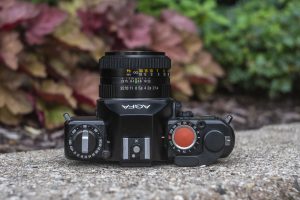
Although physically built by Chinon for AGFA, the cosmetics of the Selectronic 3 are all AGFA. Without a doubt, the first thing that jumps out at you the first time you see one of these cameras is the very large orange-red shutter release on top of the camera. This style of shutter release had been used on a large number of AGFA rangefinder and scale focus cameras, but the Selectronic series was the only SLR to have it.
Putting that aside for a moment, the rest of the top plate is rather standard. From left to right there is combined fold out rewind handle and ASA film speed selector with speeds from 25 to 3200. To prevent accidental changes to the ASA setting, a small lock button must be pressed before you can turn this dial.

Around the shutter release is the shutter speed selector with speeds from 4 seconds to 1/1000, plus Bulb, Auto, and Off. This dial was created in a way in which there is a stop in between the OFF and 1/1000 position, so you cannot rotate the dial between these two settings. If the camera is off and you want to go select a 1/1000 shutter speed, you must rotate it the complete other direction. Having the shutter speed around the border of the already large shutter release was a bold decision, making it possibly the largest diameter shutter speed dial on the top plate of any camera I’ve ever seen. This causes the front edge of the shutter speed dial to extend slightly beyond the front edge of the camera, meaning you can easily rotate the shutter speed dial with your right index finger, without ever having to lower the camera from your eye. Other cameras with a similar design like the Canon EF and Nikon FG are some of my favorites to use for this reason. Above and to the right of the shutter speed dial is a threaded socket for a cable release.
The large size of the shutter release and speed dial leaves little room for anything else other than the rapid rewind lever which is located in a comfortable location for your right thumb. The lever has a 20 degree stand off position before the lever engages the actual film advance which requires a full 180 degree motion to cock the shutter.
Finally, to the right of the film advance is the automatic resetting exposure counter. The exposure counter is additive, showing the number of exposures shot from 0 to however much is on the roll of film loaded.
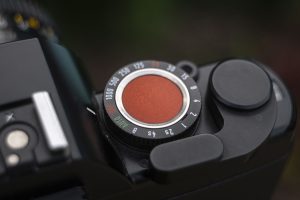
Now back to that shutter release. For as cool as it looks, it’s really just a button. Pressing it several times while writing this review, you can feel that the “action” happens mostly in the center, with the red part acting simply as a cover for a much smaller button. Travel from rest to a complete press is much shorter than other SLRs, but not as short as the Olympus XA which barely needs to move to fire the shutter. I quite liked the feeling of pressing the button, and it’s large size means that the user can alter the location of their shutter finger slightly, to accommodate longer or shorter fingers.
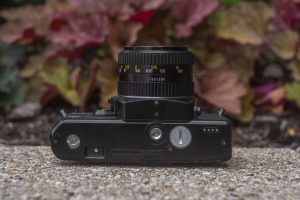
Flip the camera over, and on the bottom is the centrally located 1/4″ tripod socket, round opening for the battery compartment, rewind release button, and on opposite sites, mechanical and electrical connections for some kind of motor drive unit. The Chinon CE-4, which this camera is based on had an optional PW-530 Power Winder, but it is not clear whether this would fit the Selectronic 3, or if a dedicated AGFA unit is required. I was never able to find any sort of manual for this camera, or promotional material that explains what was needed. If I ever come across a motor drive for a CE-4, I’ll try to mount it, but until that day comes, I can only guess that it probably works.
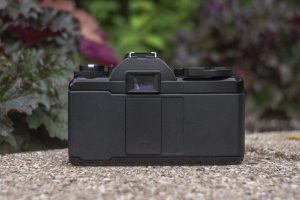
Around back is where the plasticky body of the Selectronic 3 is most obvious, as it is literally a sea of plastic. Apart from the opening for the viewfinder, the only thing to see here is a plastic clip for holding the edge of a film box loaded into the camera. I don’t normally use these types of film reminders, but the one here is different from others that act simply as a frame for the box end. On the Selectronic 3, you slide it into a crevice from the side and leave the box end sticking out.
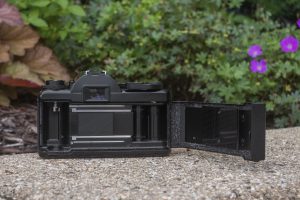
Open the film door by pulling up on the rewind lever and giving a good tug, and the right hinged film door swings open to reveal an ordinary film compartment. The film door hinge has a small pin which allows you to remove the film door, suggesting that some kind of alternate back, perhaps one with a date back or for bulk loading was planned, but I don’t believe were ever created.
Film transports from left to right onto a multi-slotted and fixed take up spool. Film winds onto the spool clockwise, which is opposite of how it is wound in the cassette, which is said to help flatten the film as it transports through the camera. Inside the door is a large and dimpled metal film pressure plate and polished film rails to ease friction on the film. Despite being made in 1980, the Selectronic 3 barely misses the era of quick load and DX film systems which would hit the market in a few short years. Notice the large foam light seals, which on this camera were degraded and needed to be replaced.

Up front, to the left of the lens is an electronic self timer with marked settings for a 5 and 10 second delay. A red LED is in the center of the dial and will flash as the camera counts down the timer. You can cancel the self-timer if you set it and change your mine, simply by turning it back to ‘0’. To the right of the self timer lever is a depth of field preview button which stops down the lens diaphragm to whatever f/stop you’ve chosen to see depth of field in the viewfinder.
Finally, above the Selectronic 3 logo is a double exposure switch which is used for intentional double exposures. When sliding this lever to the right, it temporarily disengages the film transport, allowing you to wind the camera to cock the shutter and expose a previously exposed piece of film.

Below the depth of field preview button on the left side of the lens is the lens release for the Pentax K bayonet lens mount. Like all Pentax K lenses, pressing this lever while twisting the lens counterclockwise will remove it. To reinstall the lens, simply do the opposite. Had I not had access to the original AGFA lens, I could have used any number of Pentax K mount lenses from this era without any loss of functionality.
A small button on the right side of the lens mount, near the 4 o’clock position is an exposure memory lock button which is used to memorize an exposure reading that the camera has taken, and allow the user to recompose the shot. This is useful if you want to intentionally meter for a lighter or darker portion of your exposure, while adjusting the area in which the image will be captured on film.
The viewfinder is as bright and contrasty as you’d expect from any SLR from the 1980s. With the AGFA f/1.4 lens mounted, brightness is mostly even with only the slightest hint of darkness in the corners. Not shown in the images above, but when I mounted a 50mm f/2 Pentak K-mount lens, I saw no noticeable decrease in brightness with the slower lens.
In the center is a split image focusing aide with microprism collar around it, and on the left a shutter speed scale which is indicated by red LEDs. The words “Over” and “Under” are there in red to indicate overexposure and underexposure. The shutter will still fire at these settings, but are just there to let you know you’ve exceeded the range of the Selectronic’s shutter. The entire shutter scale is superimposed over part of the viewfinder image, which isn’t much of a problem, other than the fact that you need light to be coming through that part of the viewfinder in order to see it. In dark or low light situations, this scale would be difficult to see.
For the most part, the AGFA Selectronic 3 is just like using the Chinon CE-4 it is based off, but between the large round shutter release, the all plastic body, and the intentional double exposure switch, there’s just enough to make it a worthwhile alternative. If you care about cosmetics, the Chinon is rather ordinary looking where the AGFA is quite a bit more distinct. The all plastic body, while nicer than it probably looks in pictures, isn’t better than a nice leather body covering, and the large shutter release certainly looks, and feels cool, it doesn’t make any difference in the use of the camera.
So with all these contradicting statements, how is the camera to use?
My Results
It’s rare that I get a camera that upon it’s arrival here at Mike Eckman dot Com headquarters needs nothing and is immediately ready to go (other than light seals). With a fresh battery and roll of Fuji 200 film, I threw it in to my bag on a trip to northern Michigan in late summer 2021.
As I took the inaugural roll from the tank and I got my first look at the color negatives, I was both impressed and underwhelmed at the same time. On one hand, they looked perfect, properly exposed and in focus (to the naked eye that is), but they looked like those from any other number of 1980s SLRs.
Of course, that’s really the point. In the era of the electronic shutter auto exposure SLRs cameras like the Selectronic 3 came from, images should look like pretty much everything else. When you were in the market for a midlevel SLR in 1980, you had a ton of options, and considering the positive reputation that both AGFA and Chinon had at the time, you should expect to get great images from a camera like this.
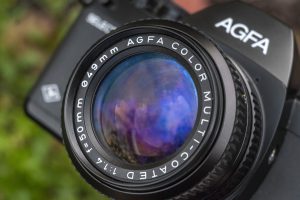
Having never shot an f/1.4 Chinon lens before, I suspected it would compare favorably to their slower lenses, and it certainly did. On paper, it always sounds more exciting to see a lens with 7-elenents compared to one with 6, 5, or 4, but if we’re being perfectly honest, you’ll never notice a difference.
Every image on that first roll was sharp corner to corner with no vignetting, chromatic aberrations, or other optical anomalies associated with lesser lenses. The deep blue and purple lens coating produced no glare and returned colors on par with what I would expect from fresh Fuji 200. In hindsight, I wish I would have chosen a film like Kodak Ektar 100 that is known for more vibrant colors, but I’ll explain in a little bit why I didn’t.
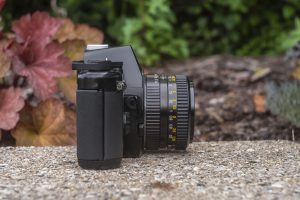
While I usually don’t aim for “bokeh” shots, the closeups of the bird feeder and brass statue with the house in the background show creamy out of focus details that I find pleasing. When you read bokeh discussions online, people often get excited about prominent soap bubble effects and strange swirls that to me, seem distracting. Sure, when done intentionally, bokeh can be used to great effect, but in my opinion, more times than not, it takes away from the image.
Using the Selectronic 3 is enjoyable, if unremarkable. The camera fits well in my hands, and all of the controls worked as I expected them too. It is neither too heavy, nor too light, too big, or too small.
Sadly, in the time between my first roll of film through the AGFA Selectronic 3 and starting this review, the camera died. I had no issues with the first roll, and at some point between putting it down and picking it up again for what I had hoped would be a second roll, it stopped responding. I tried three different sets of batteries, made sure to swab the contacts in the battery compartment with alcohol (they weren’t dirty to begin with), and gave it a few whacks with the soft part of my palm, but I couldn’t get any life out of the camera.
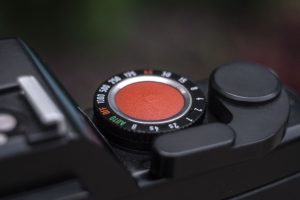
Such is life as a camera collector. There’s no telling when and how a camera will make it’s last exposure. With this being an electronic camera, it’s not likely there’s anything more I can do about it, and this kind of camera is not economic to repair, so it’ll just spend the rest of it’s days looking pretty on my shelf.
I can say however, that even before I realized the camera had died, I never truly fell in love with it. Sure, it looks cool, and who doesn’t love that big red shutter button, but the problem I have with so many electronic SLRs from this era is that they were all so good, and so similar, it’s really hard to shake the “been there, done that” feeling that even a technically excellent camera like this offers.
In good working condition, this would be an enjoyable and easy to use camera for someone looking to shoot film, but if you’re a collector looking for something that’s going to stand out and offer you something so many other SLRs don’t, this simply is not that camera.
Related Posts You Might Enjoy
External Links
http://camera-wiki.org/wiki/Agfa_Selectronic_3
https://emulsive.org/reviews/camera-reviews/agfa-camera-reviews/agfa-selectronic-3-by-mark-brown
https://www.flickr.com/photos/nefotografas/albums/72157714857548201

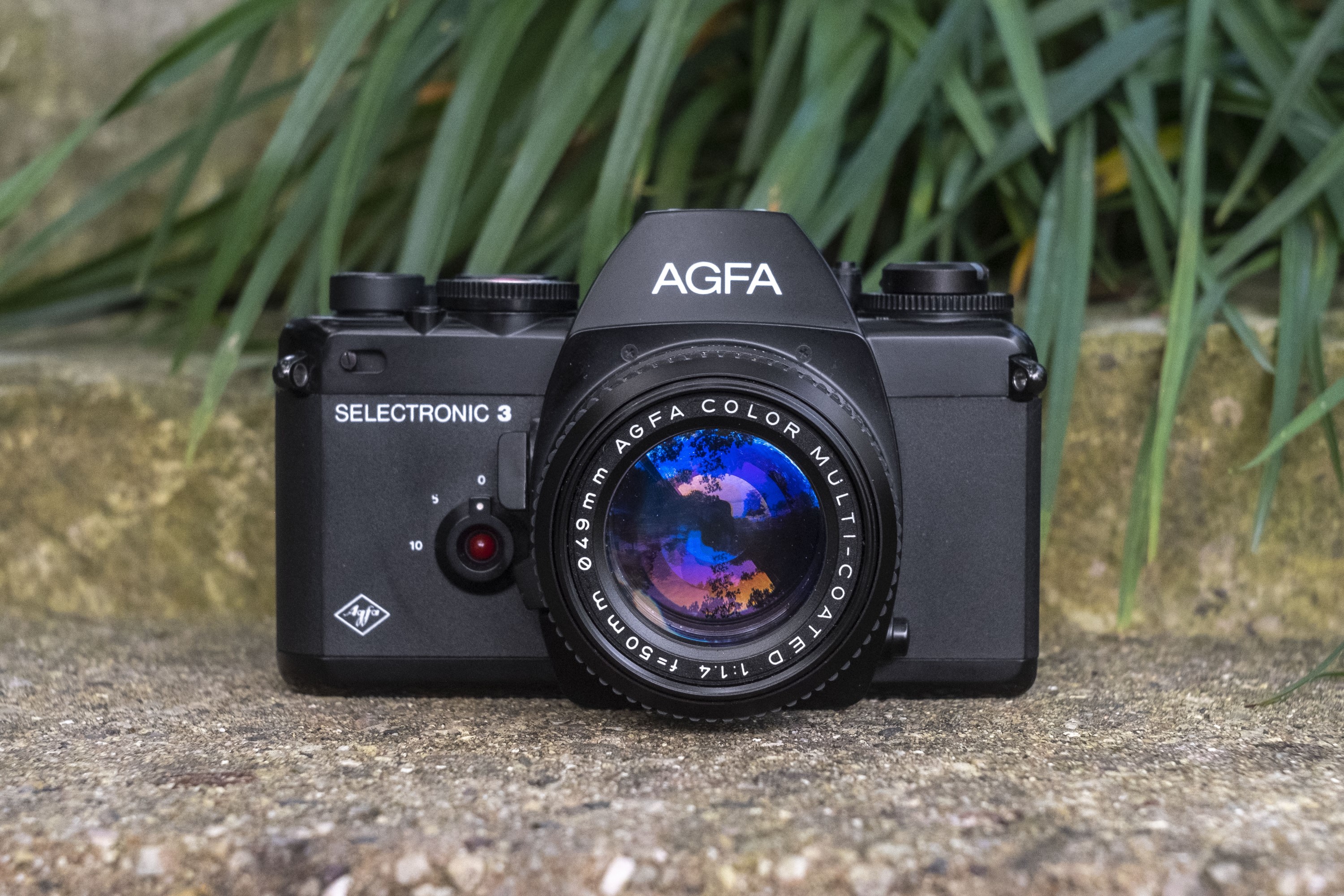
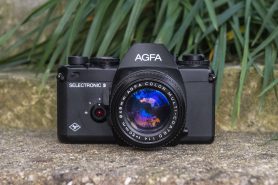
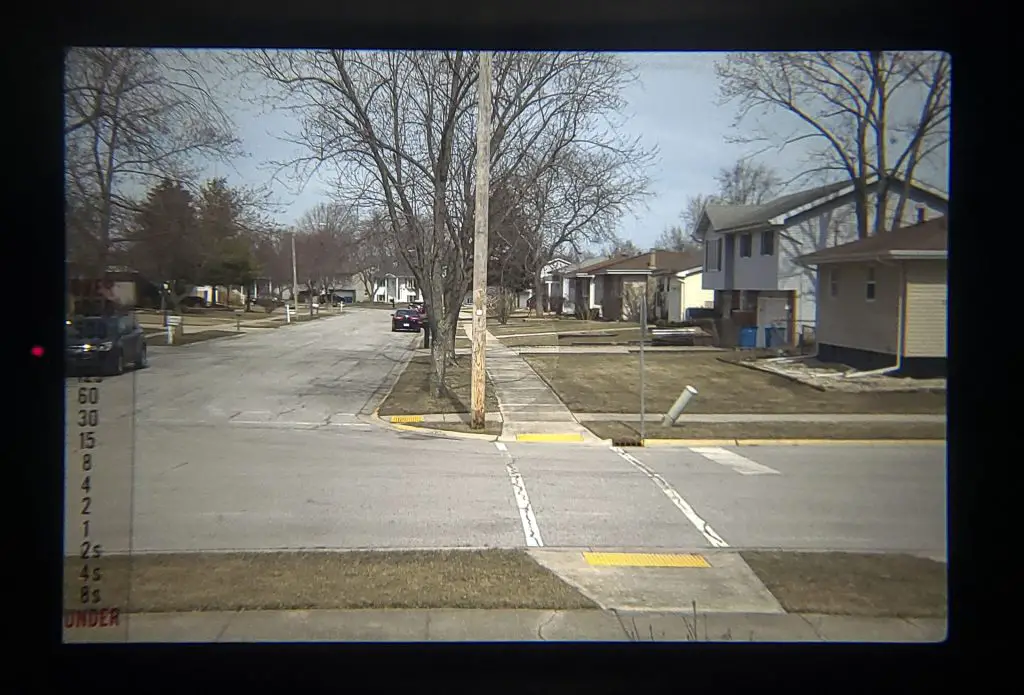
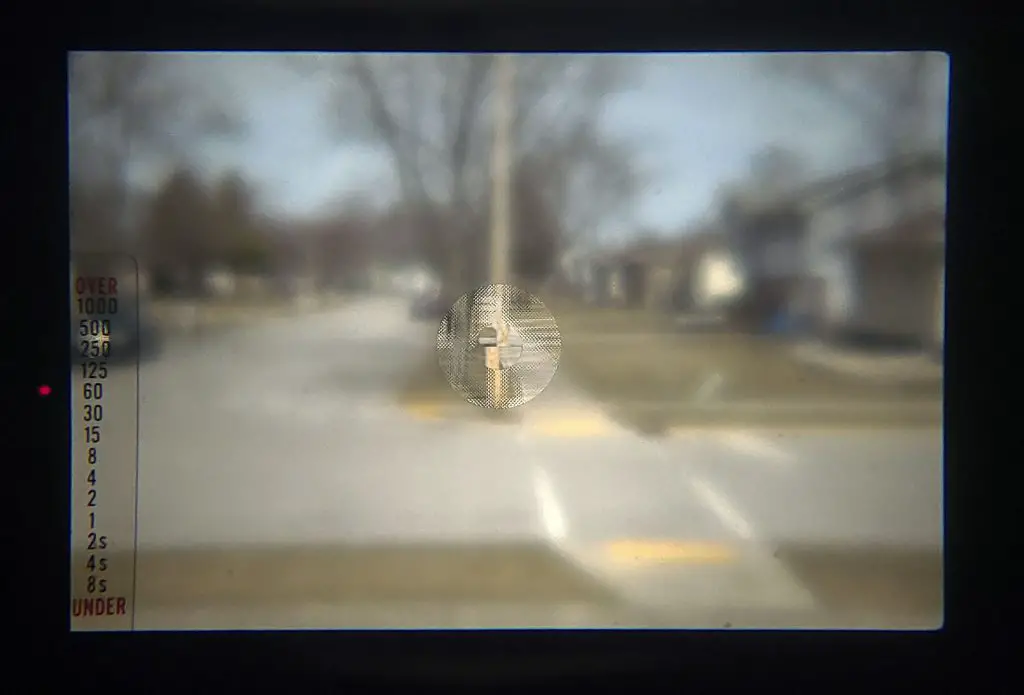

















I’ve become a fan of Agfa cameras over the years, and now have the Selectronic 1, 2, and 3 in my collection. A 3 recently showed up on eBay with the matching motor winder, so I bought it even though I don’t really need the camera.